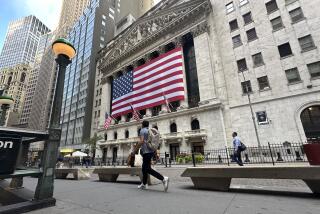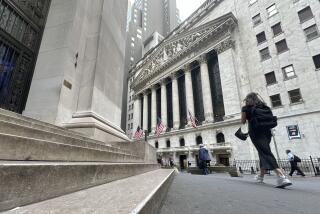For Nasdaq, a Bittersweet Anniversary
Federal Reserve Chairman Alan Greenspan last week declared the recession over and a recovery “well underway.”
It’s purely coincidence that Greenspan’s declaration arrived two years to the week the Nasdaq composite stock index reached its all-time high of 5,048.62. That turned out to be the exclamation point on the technology stock mania that defined the late 1990s, and the beginning of the “new economy’s” painful comeuppance.
If recovery is here for the broad economy, what about recovery for the Nasdaq index, which at 1,929.67 on Friday still is down 62% from its peak? Will most investors see 5,000 again in their lifetimes?
Those questions have mere curiosity value for many people, but for others--those who bought technology stocks in 1999 or early 2000 and have held on--this is about serious money.
Tech investors have to feel better after last week, which saw the Nasdaq index surge 7% as Wall Street took Greenspan’s upbeat views on the economy to heart. The broad market also advanced, with the Dow Jones industrials adding 2% for the week, to 10,572.49 by Friday, and the Standard & Poor’s 500 rising 2.9%.
If the Dow gains 11% from here, it will surpass its record high of 11,722 set in January 2000. The S&P; 500, by contrast, needs a 31% advance to retake its all-time high, which like Nasdaq’s was reached in March 2000.
For Nasdaq, the challenge of getting back to 5,000 is truly monumental, mathematically speaking: The index would have to soar 162% from Friday’s close to eclipse the old bull-market peak.
The temptation is to instantly dismiss the idea of a return to the vicinity of 5,000 any time soon as wishful thinking or worse; given the excesses that the Nasdaq peak represented in terms of rank speculation and ignorance of basic investing tenets, asking for 5,000 would seem to be begging for another disaster.
But as stocks and stock indexes go, it isn’t the nominal price level that’s important, of course. What matters is that price level relative to what’s behind it in terms of corporate asset values and earnings, and relative to what’s happening in the economy as a whole, especially with interest rates.
Recent history includes two drastic market declines that were substantially recouped much faster than many investors imagined when they were looking up from the bear-market bottoms:
* In 1973-74, the S&P; 500 plunged nearly 50%, the worst decline since the 1929-32 bear market, amid soaring oil prices and inflation, President Nixon’s resignation and a host of other troubles.
But within two years of the S&P;’s bottom (reached in December 1974), the index had gained back 80% of what it lost.
* In 1987, the Dow index plummeted from a high of 2,722 to a low of 1,738 in the course of two months, including the 508-point, 22.6% decline of Black Monday, Oct. 19, 1987.
Many investors at the time wondered whether they’d ever see a Dow of 2,700 again. Yet by late 1989, the index was at a new high.
For a number of reasons, however, many Wall Street pros say Nasdaq’s rise and fall probably are better compared with what happened to blue-chip shares in the late 1920s and early 1930s.
From its peak in the speculative frenzy of 1929, the Dow index lost 90% by the time in bottomed in July 1932. In Nasdaq’s case, the decline from the March 2000 peak to Sept. 21, the low of the last year, was 72%.
Anyone hoping for a 5,000 Nasdaq in the next few years won’t be encouraged by the Dow’s track record after the 1932 market bottom: It wasn’t until 1954 that the Dow returned to its 1929 level.
Could a return to Nasdaq 5,000 likewise take 25 years? That may seem to be an absurd proposition in the absence of the devastating events what weighed on the market in the 1930s and ‘40s (the Depression and World War II).
But even if investors knew they had to wait 10 years for Nasdaq and its major tech stocks just to get near their old peaks, many might find that to be interminable.
Louise Yamada, a market chart-watcher at brokerage Salomon Smith Barney in New York, said she wouldn’t hazard a guess about the time required to retake the old Nasdaq peak. But the case against getting there any time soon, she said, is that “it’s unlikely that a bubble is going to be followed [quickly] by another bubble,” at least in the same market sector.
Some analysts say the best argument against a huge new rally in most technology stocks is that the late-1990s bubble only deflated somewhat, but didn’t burst.
How so? Because the bubble wasn’t 5,000 itself, but tech shares’ price-to-earnings ratios at 5,000. Now, though tech stock prices have collapsed since March 2000, so have the companies’ earnings. As many frustrated bargain hunters know all too well, tech price-to-earnings ratios remain in the stratosphere when comparing current share prices with estimated 2002 earnings and in some cases when comparing with results expected in 2003.
Consider networking giant Cisco Systems. Friday’s closing stock price was $17.80, down 78% from the March 2000 peak of $79.38. But Cisco is expected to earn 32 cents a share in the fiscal year ending in July and 47 cents next year, according to the average estimate of analysts surveyed by Thomson Financial/IBES.
That means the stock is priced at 56 times this year’s earnings estimate and 38 times next year’s estimate. The average blue-chip stock, by contrast, is priced between 20 and 25 times this year’s estimated earnings.
Another example: Shares of KLA Tencor, a maker of semiconductor manufacturing equipment, helped stoke the Nasdaq rally last week, reaching a 52-week high of $69.47 by Friday. At that price, investors are paying 69 times the average analyst earnings estimate for this fiscal year and 53 times the following year’s estimated results.
It’s possible that analysts are severely underestimating the potential earnings recoveries of tech firms such as Cisco and KLA Tencor. But it’s also possible that analysts are overestimating earnings, if the economic recovery turns out to be a dud.
In any case, there are few analysts on Wall Street who are arguing that tech stocks in general are cheap today.
If valuation concerns keep the stocks of Nasdaq’s technology titans, including Cisco, Dell Computer, Oracle and Intel, from heading to the moon again, then the 5,000 level on the Nasdaq composite index may be very difficult to get near. The simple reason: The index is market-capitalization-weighted. That means the largest stocks by market capitalization (stock prices multiplied by the number of shares outstanding) matter most in determining the index’s price changes.
Though Cisco, Dell and Intel shares are shadows of their former selves, they still are the dominant stocks by market cap in the Nasdaq market. Thus, as they go, so the Nasdaq index is likely to go.
What’s more, the dominance of those tech giants has been abetted by the loss of hundreds of other stocks from Nasdaq’s ranks over the last few years because of failures, mergers or delistings. Nasdaq now lists shares of 4,072 companies, down from more than 5,500 at the peak in the late ‘90s.
Many of the small and mid-size stocks that are left on Nasdaq continue to perform well. That’s evident in the year-to-date gains of indexes such as the S&P; small-cap 600, which is up 5%.
In fact, in some non-tech Nasdaq sectors, stocks have been reaching new highs lately. Financial stocks, in particular, have been hot. The Nasdaq financial-100 index, packed with regional banks, smaller brokerages and insurance firms, hit a record Wednesday and is up 7.3% this year.
But the weight of the tech giants is such that the Nasdaq composite remains in the red this year, even after last week’s rally. The index is down 1.1% since Dec. 31.
Who cares if Nasdaq never approaches 5,000 again? some investors rightly note: There still will be plenty of opportunities to make money in Nasdaq stocks, as the financial sector is demonstrating. (Don’t drive the car while looking only in the rearview mirror, as the old investing line goes.)
There also are some analysts who warn that it would be a big mistake to underestimate the potential for the technology sector to spawn tremendous new products in this decade. When that happens, companies that may be afterthoughts on Nasdaq today, or that aren’t yet even public, could become exciting new leaders, with market caps to match.
“There’s a [tech] event out there that’s going to capture everyone’s imagination, and there we will go again,” said Jim Glassman, economist at J.P. Morgan Chase in New York.
*
Tom Petruno can be reached at tom.petruno@latimes.com.
More to Read
Inside the business of entertainment
The Wide Shot brings you news, analysis and insights on everything from streaming wars to production — and what it all means for the future.
You may occasionally receive promotional content from the Los Angeles Times.










